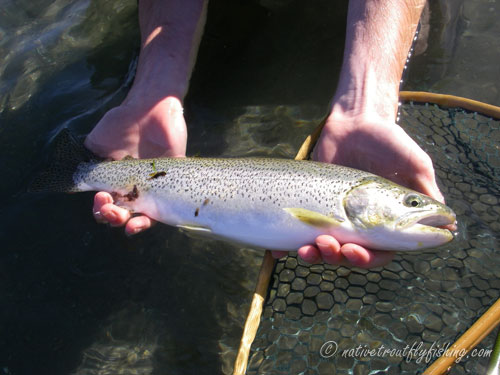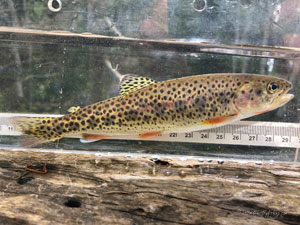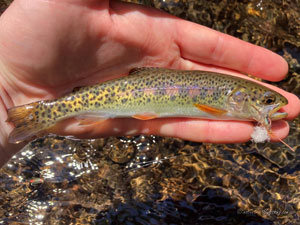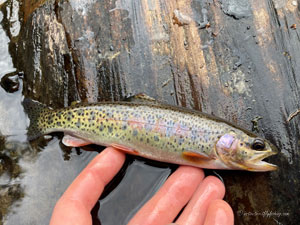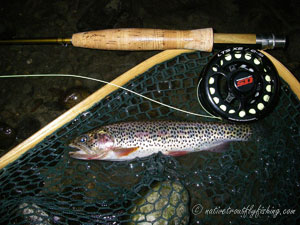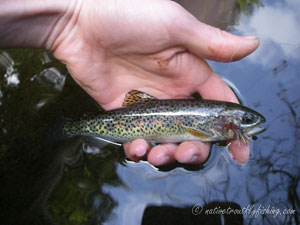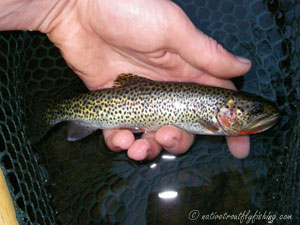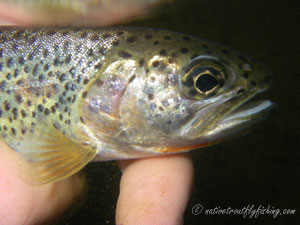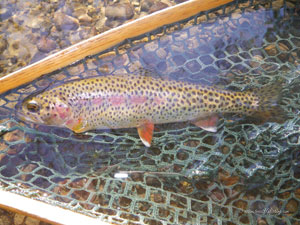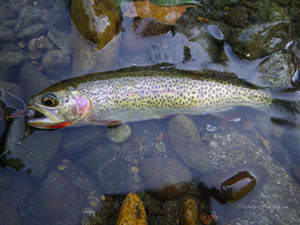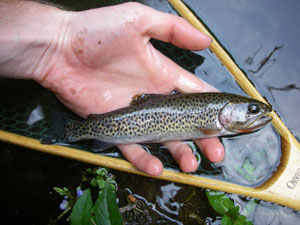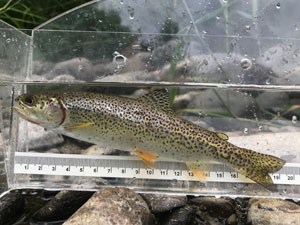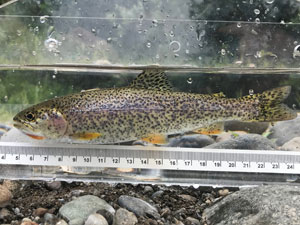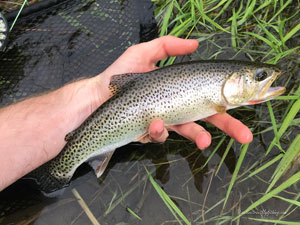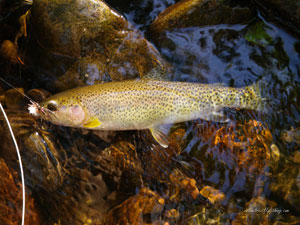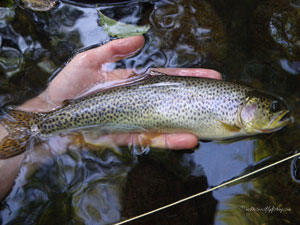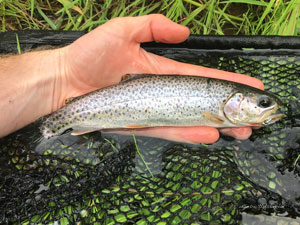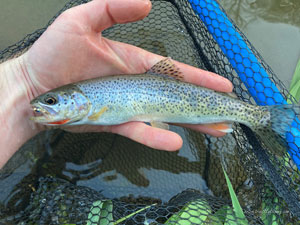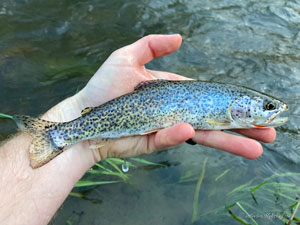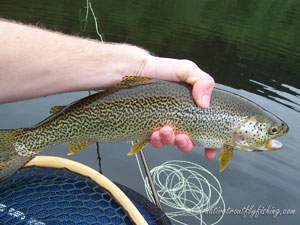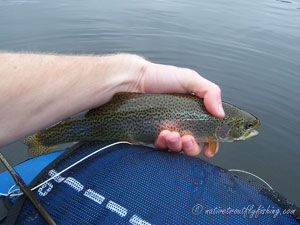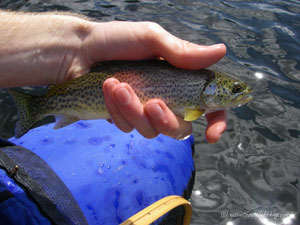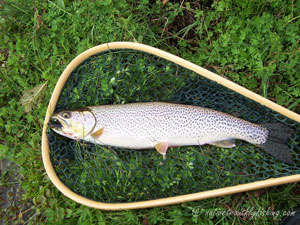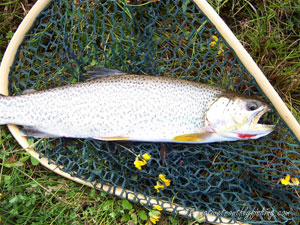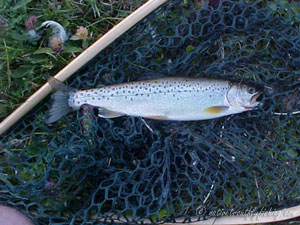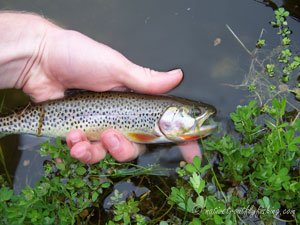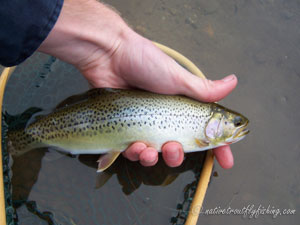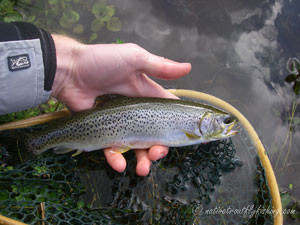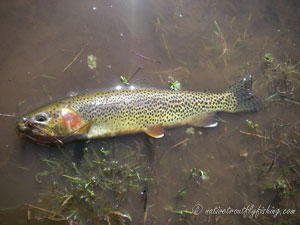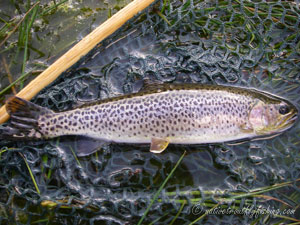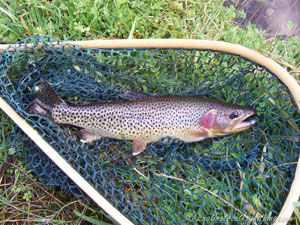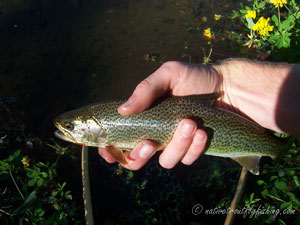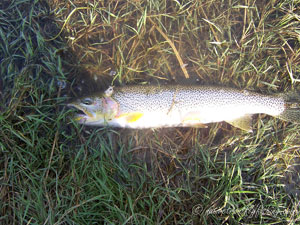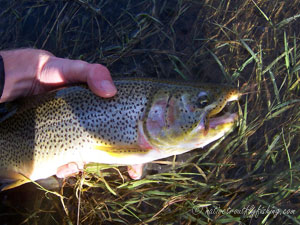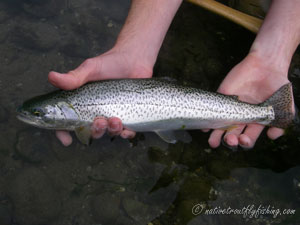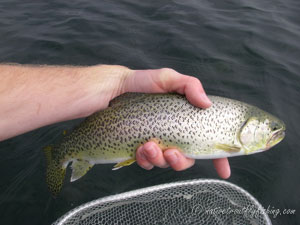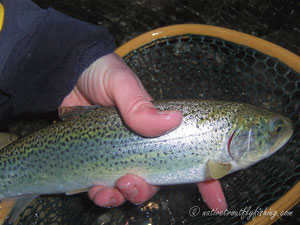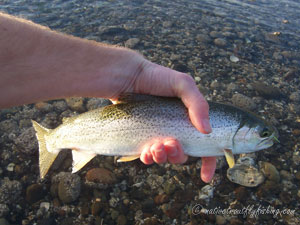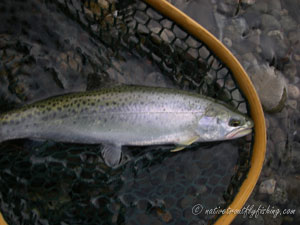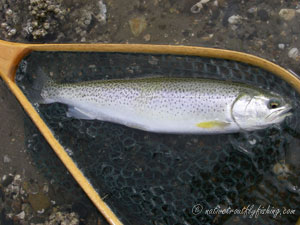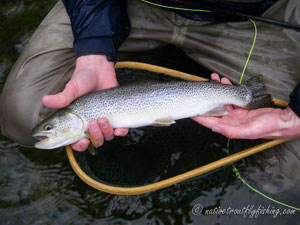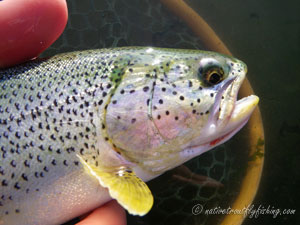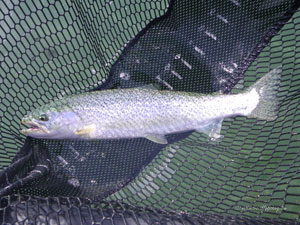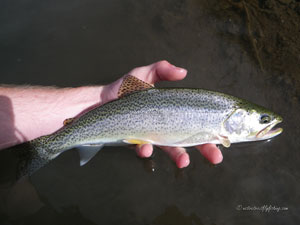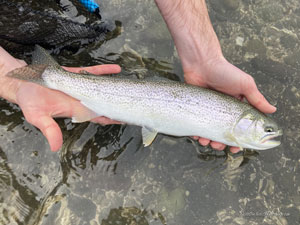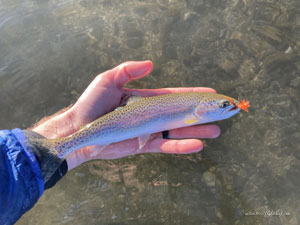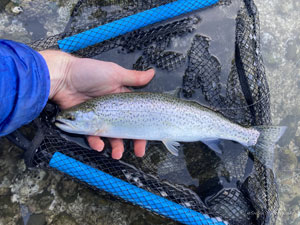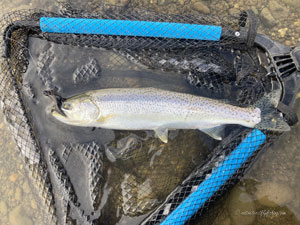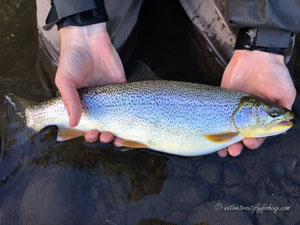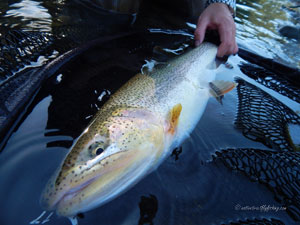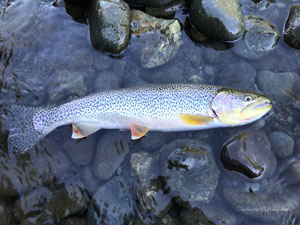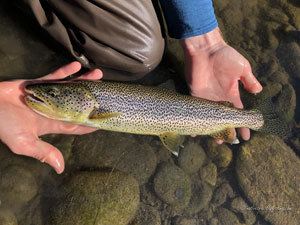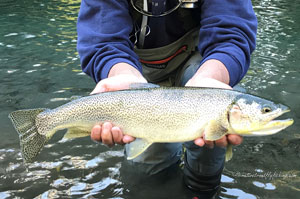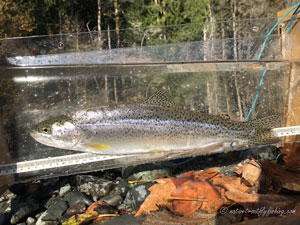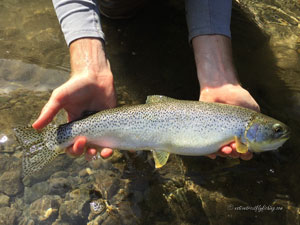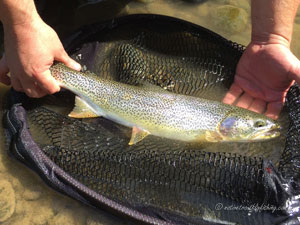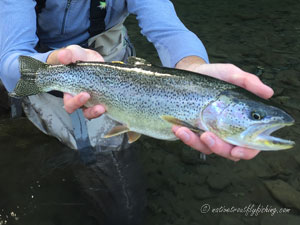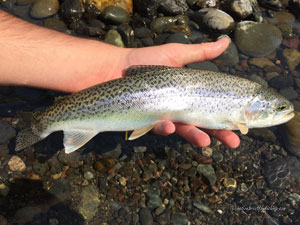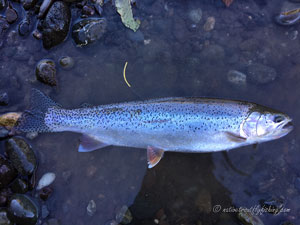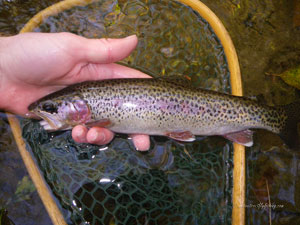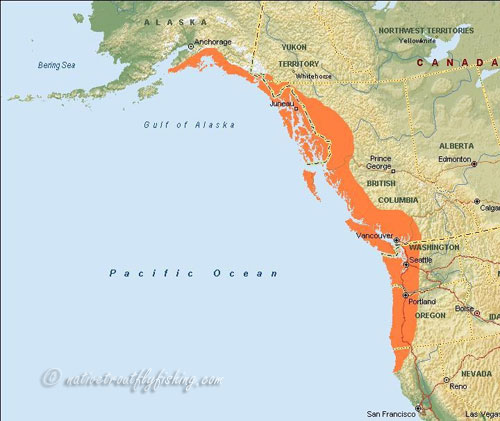Coastal Cutthroat
Oncorhynchus clarkii
An anadromous Coastal Cutthroat from Washington State's Puget Sound.
Introduction
The Coastal Cutthroat Trout is considered one of four species of Cutthroat Trout and is classified as Oncorhynchus clarkii (Trotter et al. 2018). Coastal Cutthroat are native to the temperate rainforest belt, which runs for approximately 2,000 miles (3,220 km) along the west coast of North America, from the Eel River in Northern California to Prince William Sound, Alaska (See Map). The Coastal Cutthroat Trout was first described as Salmo clarkii from specimens collected in the Lewis River, a tributary of the lower Columbia River in 1836 (Richardson 1986) and are the only species of Cutthroat Trout to utilize the marine environment during its life history. Unlike other species of Cutthroat Trout, the Coastal Cutthroat does not have any divergent subspecies, although there is evidence that indicates that there are three distinct clades of Coastal Cutthroat that represent glacial refuge populations that recolonized their current native range after the last ice age (Williams et al. 2018). The lack of any distinct subspecies across such a large native range likely due to their migratory life history, which has allowed them to maintain connectivity between populations. Coastal Cutthroat overlap with Coastal Rainbow Trout across much of their native range and although relatively infrequent, are known to naturally hybridize with each other. Other names that are commonly attributed for Coastal Cutthroat include, sea-run Cutthroat, harvest trout, speckled trout, and blueback trout.
Life History Information
Coastal Cutthroat Trout exhibit a wide variety of life history strategies with stream resident, fluvial, lacustrine, and anadromous populations occurring across their native range. Like all Pacific trout, Coastal Cutthroat are iteroparous meaning that they can spawn more than once. The survival rate for Coastal Cutthroat returning to spawn a second time is relatively high (up to 40%) and they have been documented to spawn as many as five times (Behnke 2002). Coastal Cutthroat are typically a winter to-spring spawning fish, with the spawning period extending from December through May in most populations. In the southern part of their range from British Columbia to California, the bulk of the Cutthroat spawn in February, but in Alaska April or May spawning is more common (Trotter 1989). Much of this spawning occurs in small streams, which contribute a disproportionate amount of rearing habitat for juvenile Coastal Cutthroat when compared with larger streams (Rosenfeld et al. 2002).
Stream Resident Form
Both stream resident and fluvial (river migratory) life history forms of Coastal Cutthroat are common across their native range, with stream resident populations often occurring in small streams above barrier falls, while fluvial populations typically occur in larger watersheds. Populations of stream resident Coastal Cutthroat are primarily drift feeders, preying on both aquatic and terrestrial invertebrates and generally have a maximum size of around 12” (30 cm) with most individuals between 6-7” (15-18 cm) (Behnke 2002, Trotter 2008). Likely due to the limited growth opportunities in the cool nutrient poor streams of the Pacific Northwest, these stream resident fish have relatively short life spans, with most living to age-3 and a few to age-5 (Rehe 2006, Rehe and Gresswell 2008, Totter 2008). Most stream resident Coastal Cutthroat have small home ranges, only moving between 7 and 312 feet (2-95 m) up or downstream throughout the year, with the greatest movement occurring in April when spawning peaks (Gresswell and Hendricks 2007). During summer stream resident fish do not seem to make directed migrations, instead making short upstream and downstream movements between periods of holding in a single location or moving into beaver ponds when available (Saiget et al. 2008). While most stream resident Cutthroat typically spawning in the spring, a population in Indian Creek, which is a tributary to the Elwha River in Washington spawn in October and November (McMillan et al. 2014). Indian Creek has a lake upstream, which regulates and stabilizes the flows and water temperatures in the basin and has likely allowed this unusual spawn timing to evolve. Trout in these stream resident populations, typically first spawn at age-2 to age-3 and females typically lay between 50 and 250 eggs (Trotter 2008). Where there are no barriers to migration, small stream resident males have been observed spawning with larger migratory females. Interestingly, while many stream resident populations have been isolated above barrier waterfalls for long periods of time (~10,000 years in some cases), they often retain high levels of genetic diversity (Whiteley et al. 2010, Williams et al. 2018).
Fluvial (River Migratory) Form
While stream resident forms are relatively well understood, less is known about fluvial forms with fewer studies focusing of this life history form. While some fluvial populations occur upstream of migration barriers, such as in the Snoqualmie and Deschutes Rivers in Washington and Willamette River in Oregon, others occur in watersheds with access to marine waters, such as in the Rouge and Umpqua Rivers in Oregon making differentiating anadromous and fluvial populations difficult (Tomasson 1978, Trotter 2008). Based on what is known, these fish show similar patterns of migration to and from spawning streams as anadromous populations and are also highly dependent on small streams as rearing habitat (Saiget et al. 2007). Juvenile fluvial Coastal Cutthroat typically rear in the natal streams for 1 to 3 years, but often migrate downstream a year earlier than anadromous populations (Moring et al. 1986). Additionally, juvenile fluvial Cutthroat have also been observed to grow at a quicker rate than their stream resident counterparts (Tomasson 1978). Fluvial Coastal Cutthroat typically forage in larger river systems, feeding opportunistically on a diet of aquatic and terrestrial invertebrates as well as fish, with larger fluvial fish typically found lower in the watersheds (Overman 2008, Trotter 2008). Tomasson (1978) showed that fluvial Coastal Cutthroat in the Rouge River distributed throughout the main stem of the river and showed similar growth rates to anadromous Cutthroat. As such lengths of 16” to 22” (41-56 cm) are not uncommon in fluvial Coastal Cutthroat populations (Trotter 2008). Where they co-occur with Coastal Rainbow Trout, fluvial Cutthroat tend to utilize under-cut banks, woody debris, and slower deeper pools, whereas Rainbows are often found in faster riffles and runs. Starting in the late-fall large fluvial Coastal Cutthroat often migrate upstream, in part due to spawning but likely also to overwinter (Connolly et al. 1992). Fluvial Cutthroat in the Willamette Basin primarily spawn from January through March, but timing is highly variable depending on flow temperature and elevation (Moring and Youker 1979). In the Middle Fork of the Snoqualmie River some fluvial Cutthroat were shown to first spawn at age-2, although first time spawning at age-3 was more common (Overman 2008). In the Rogue River, a maximum age of four was common in fluvial Coastal Cutthroat, while fish up to age-6 have been found in other populations (Tomasson 1978, Overman 2008, Trotter 2008).
Adfluvial (Stream to Lake Migratory) Form
Lake adapted Coastal Cutthroat have the potential of attaining the largest size as well as the oldest age of any life history form of Coastal Cutthroat. Adfluvial Coastal Cutthroat are common across their native range and utilize waterbodies ranging from the size of beaver ponds to large lakes like Lake Washington. Two unique lacustrine populations of Coastal Cutthroat occur in Crescent Lake in Olympic National Park, an ultraoligotrophic lake that produced the Washington State record Coastal Cutthroat a 12 lb (7.4 kg) fish (Trotter 2008). These fish were cut off from access to the sea and other populations of Cutthroat by a massive landslide. At one time the lake was thought to hold two unique subspecies known as the Crescenti Cutthroat (Oncorhynchus clarkii crescenti) and the Long-headed Trout (Oncorhynchus clarkii bathoecetor), due to their unique morphology and silvery appearance. However, taxonomic studies have shown that these fish are simply an isolated lacustrine Coastal Cutthroat population (Behnke 1992). Despite this the Cutthroat in the lake show three distinct spawning patterns, with one group spawning in the lake’s inlet Barnes Creek from February to early June. Another group of Cutthroat migrate to the lake’s outlet the Lyre River from September through March, with spawning peaking in late December (Brenkman et al. 2014). This unusually early spawning is similar to the pattern observed in Indian Creek, a tributary to the Elwha River and the lake’s former outlet (McMillan et al. 2014). The final spawning aggregate in the lake are shoal spawners, which spawn along the western shoreline of the lake during March. While shoal spawning is not common in Coastal Cutthroat populations, it has also been observed in Bull Run Lake in Oregon, where Coastal Cutthroat spawn in shoals during May-June, a month earlier than tributary spawners and typically spawned and with most spawning occurring near larger rocks or boulders in water from 1 to greater than 12 feet deep (0.3 to 3.7 m) (Saiget 2008b). Other adfluvial Coastal Cutthroat show a similar spawn timing to the Barnes Creek population. Adfluvial Cutthroat in tributaries to Lake Washington have been observed spawning between December and June, with peak spawning in February and March (McMillan et al. 2008). Cutthroat in Irely Lake in Olympic National Park have been shown to have a later spawn timing than neighboring anadromous populations, with peak spawning in in early-April selecting sites in Irely Creek with large gravel to small cobble for their redds (Vadas et al. 2008). Adfluvial Cutthroat in Alaska also spawned in spring, but began maturing during fall, with spawners ranging from age-4 to age-12 with years between spawning events evident (Foster 2003).
Just as the spawning patterns of lacustrine Coastal Cutthroat are highly variable, so are the emergence patterns. In Lake Crescent, the Barnes Creek populations typically incubate for 75 days, with an addition 64 days to emergence in June-August. In contrast, the Lyre River spawners experience wide range of temperatures and emerge from between November and late-May (Brenkman et al. 2014). Juvenile adfluvial Coastal Cutthroat often rear in tributaries for their first 2 years, after which time they migrate into the lakes. In Lake Washington, Coastal Cutthroat initially forage along the shoreline primarily preying on Daphnia and aquatic invertebrates, but after they reach a size of 10” (25 cm), they move offshore into open waters where they prey on juvenile Sockeye Salmon, Threespine Stickleback and Long-fin Smelt, with age-0 long-fin smelt being their preferred prey item (Beauchamp et al. 1992, Nowak et al. 2004, Hansen and Beauchamp 2014a). Once in open waters, Cutthroat tend to hold near the thermocline, avoiding surface waters during the warmer months of the year, but are more surface oriented when the lake is mixed (Nowak and Quinn 2001). A similar pattern to this is found in Sproat Lake, British Columbia, where larger Cutthroat were found in the open waters compared to along the shoreline, suggesting that they were foraging in the pelagic zone of the lake (Anderson 2016). In Lake Ozette, Washington large Coastal Cutthroat also inhabited the pelagic zone of the lake, with 40% of the diet of these fish consists of age-0 and age-1 Sockeye Salmon during the spring and summer (Beauchamp et al. 1995). For larger Cutthroat, shoreline foraging primarily occurs in the spring coinciding with spawning and juvenile salmon entering the lakes (Nowak and Quinn 2001). As the Cutthroat grow larger, fish become increasingly prevalent in their diets, with fish making up 22.5% of the diet of Cutthroat under 8” (20 cm) and 95% of the diet in Cutthroat over 16” (40 cm) (Nowak et al. 2004). Interestingly, due to changes in the condition of Lake Washington, foraging conditions for Coastal Cutthroat have become more ideal. The first change was a significant clearing of the lake, primarily due to treatment of effluent entering the lake and the second has been an increase in light pollution due to urbanization associated with Seattle. This increase in light and improvement in water quality allows the Cutthroat to successfully forage at night when prey would otherwise be unavailable to Cutthroat in other less urbanized lakes. Hansen and Beauchamp (2014) showed that the diets of Cutthroat in Lake Washington contained a higher percent frequency of fish at night compared to other periods of the day. With these changes, Cutthroat in Lake Washington reach exceptional size, with a fish caught in 2002 weighing in at 14.9 lbs. (on an unofficial scale) (Trotter 2008). In smaller lakes, where a pelagic life history is not possible Cutthroat do not typically attain as large of sizes and their diets often dominated with by aquatic invertebrates, with plankton being important during late-winter and spring and fish important spring through fall (Bulkley et al. 1966).
Anadromous (Sea-Run) Form
While Steelhead and Salmon typically travel hundreds or even thousands of miles during their time at sea, Coastal Cutthroat are more of home bodies and tend to stay within the confines of the estuary. Within the anadromous life history of Coastal Cutthroat Trout, both ocean migrants and estuarine migrants are relatively common and anadromous Coastal Cutthroat show a great amount of diversity throughout their native range, with run timings and habits being highly variable. Generally, these fish will spend less than a year in the marine environment before returning to their natal streams to spawn. However, in South Puget Sound, sea-run Cutthroat have been observed returning to freshwater once annually, migrating to freshwater multiple times annually and overwintering in marine waters before returning to freshwater with 68% having mothers that had overwintered and matured in saltwater prior to spawning (Claiborne et al. 2020). However, in other populations sea-run Cutthroat may return to freshwater simply to overwinter and may or may not spawn upon returning. In the Columbia River up to 50% of returning Coastal Cutthroat are either first spawners or non-spawning overwintering fish that had returned to spawn during a previous year (SEI Panel 2001). Sea-run Cutthroat from the Copper River typically overwinter in lakes or ponds arriving in the from September to November and 179-194 days before migrating into tributaries to spawn (Saiget et al. 2007). Additionally, the time of return to fresh water varies greatly and, Johnston (1982) identified two distinct adult return times for sea-run Cutthroat, with an early-run that peak in large streams in September and October and a late-run that returns to small streams in December and January. In some cases, these two run timings of sea-run fish occur in the same watershed, such as in the Stillaguamish River, which is noted for having an early run that arrives in late summer through fall and a later run arriving from December through March (Behnke 2002). Typically, the early run timing is associated with over-wintering and is common in the larger rivers around the Northwest. These early run fish may or may not be from the stream that they are returning to. In a study investigating fin-ray microchemistry of Coastal Cutthroat and Coastal Rainbow Hood Canal Rivers, sea-run Cutthroat entered the rivers along with returning Pacific Salmon but had maternal Strontium and Calcium signatures significantly different than resident Coastal Rainbow Trout suggesting that they were born in different watersheds (Campbell and Marston unpublished data). The early return of these fish coincides with the return of spawning Pacific salmon, whose eggs the Cutthroat feed heavily on. In contrast, the later run timing is typically more common in small streams feeding directly to the saltwater and is associated with spawning migrations (Trotter 2008).
Spawn timing for anadromous Coastal Cutthroat is variable across their range, typically occurring between December and May with spawning occurring later further north. However, in some populations in Southeast Alaska, anadromous Coastal Cutthroat spawn in late summer or early fall, generally after only a few months at sea (Lukey 2008). In the small streams draining to Puget Sound, annual spawning timing changes year to year and is often dependent on periods of high flows which allow Cutthroat to ascend their spawning streams (Losee et al. 2016). Upon entering their spawning streams sea-runs tend to seek out areas with high gradient and narrow channels in the headwaters of smaller tributaries or the upper reaches of larger tributary streams, which has helped to segregate them from Coastal Rainbow Trout, which typically utilize lower gradient areas with wider channels lower in the watersheds (Buehrens et al. 2013). This has the result of limiting hybridization between the two species, where both occur. During spawning Coastal Cutthroat have been observed to continue feeding, with diets often consisting of salmon eggs when the spawning of both Cutthroat and salmon overlaps (Ellings et al. 2008). Female fecundity increases with age and size, but typically ranges from 226 to 4,420 eggs (Pearcy et al. 2018). Spawning mortality has been shown to be high in a number of streams, which along with the use of small headwater streams for spawning may partially explain the relatively small size of sea-run Cutthroat (Tomasson 1978, Vogt 2017). While sea-run Coastal Cutthroat have a maximum life span of between seven and nine years, most do not live past age-5 (Tomasson 1978, Behnke 2002, Claiborne et al. 2020).
Juvenile Coastal Cutthroat typically emerge in March-June and with fry utilizing shallow areas near the stream banks on in off-channel areas during their first summer, with small streams being particularly important rearing habitat juvenile Cutthroat (Rosenfeld et al. 2002, Lukey 2008, Pearcy et al. 2018). While in freshwater, juvenile Coastal Cutthroat are predominately drift feeders feeding on aquatic and terrestrial invertebrates. Where they co-occur with Coho Salmon, juvenile Cutthroat tend to be smaller and rear in riffles, while juvenile Coho use pools and glides with both species feeding predominately on aquatic invertebrates (Glova 1984). However, when Pacific Salmon return juvenile Cutthroat will shift to feeding predominately on eggs, which result in a high caloric intake during spring compared to populations where salmon eggs are not available (Ellings et al. 2008). Smolts typically enter the salt water from March to June at an age of two to five years old, with later timing and older ages for smolts found in the northern part of their range (Trotter 2008, Johnson et al. 1999). After entering marine waters, Cutthroat smolts become increasingly piscivorous once the grow larger than 5.5” (14 cm) (Duffy and Beauchamp 2008). Kelts, which are post-spawn fish returning to the saltwater, generally migrate out to sea around the same time as the smolts. This timing often coincides with the out migration of juvenile salmon, which provide an important food source for sea-run Cutthroat and account for more than 50% of the diet of sea-run Cutthroat in Puget Sound from April-June (Duffy and Beauchamp 2008). Upon smolting in between March and May, Coastal Cutthroat in tributaries to the lower Columbia River leave their tributaries and make directed migrations into the ocean, with a mean travel time of 5 days after entering the mainstem Columbia River, although some fish did remain in the estuary throughout the summer (Zydlewski et al. 2008, Herring et al. 2009). In contrast Coastal Cutthroat kelts from the lower Columbia River make much more extensive use of freshwater water after moving out of tributaries. These Cutthroat typically remained in the lower Columbia for 1-60 days before moving into marine waters, occupying the mainstem, side channels, backwaters, and other tributary streams (Hudson et al. 2008). These Columbia River Cutthroat often make extensive migrations and are found further offshore than Coastal Cutthroat populations in more protected waters such as the Salish Sea. One fish from the lower Columbia River was documented traveling 40 miles (65 km) south of the Columbia River in two weeks and most travel 6-28 miles (10-45 km) off the Coast of Washington and Oregon (Johnston 1982, Zydlewski et al. 2008). Similar patterns have also been found in marine waters off the coast of California, Oregon, and Washington, with fish being caught in surface waters between May and August, however very little is known about these ocean-migrations (Pearcy et al. 2018). In contrast, in many coastal rivers, Cutthroat may exhibit a strictly estuarine life history, where they never migrate to the open ocean. Instead, these fish forage in the tidally influences portions of the rivers, exhibiting strong site fidelity to specific locations and favoring main stem sites over marsh and side channel habitat (Krentz et al. 2008). While in the estuary these Cutthroat become increasingly piscivorous although invertebrates still typically make up 15% of the diet of larger 11-16” fish (28-40 cm) (Jones et al. 2008). While estuarine resident Cutthroat are highly opportunistic, they appear to select for certain prey items depending on the habitat they are utilizing. In the Hood Canal and South Puget Sound, most Coastal Cutthroat remain within 6 miles (10 km) of their natal streams and are typically shore oriented, but some fish do travel over 25 miles (40 km) from their natal streams (Goetz et al. 2013, Losee et al. 2017). Interestingly Coastal Cutthroat x Coastal Rainbow Trout hybrids from the Hood Canal appeared to travel much further than pure Coastal Cutthroat and with migrations that represent an intermediate between sea-run Cutthroat and Steelhead (Moore et al. 2010). While in marine waters Cutthroat seem to have a strong site fidelity and are often found along the same beaches throughout the year (Losee et al. 2018). This is not to say that Coastal Cutthroat do not travel between different beaches, as I have personally recaptured an 18” (46 cm) Cutthroat feeding on juvenile Chum Salmon off two creek mouths that were 6 miles (10 km) apart and on the opposite shoreline of the Hood Canal a week apart during the spring. Similar behavior to this is found in South Puget Sound, where Haque (2008) showed that Coastal Cutthroat movements are highly tied to Chum Salmon. While in the marine environment Coastal Cutthroat prefer shallower nearshore waters between ten and twenty feet deep and feed heavily on baitfish such as Pacific Sand Lance, Staghorn Sculpin, Shinner Perch salmon fry, and Pacific Herring (Jauqet 2002, Duffy and Beauchamp 2008, Pearcy et al. 2018). Krill and other small crustaceans as well as Polychaetae worms also make up a substantial portion of their diet, especially for Coastal Cutthroat overwintering in the saltwater (Jauqet 2002). While foraging in marine waters, Coastal Cutthroat growth as fast, however, despite this and unlike other anadromous salmonids Coastal Cutthroat do not attain a very large size in marine waters with an apparent maximum size of around 6-7 lbs. (2.7 to 3.2 kg) (Behnke 2002).
Status
Unlike other species of Cutthroat Trout, the Coastal Cutthroat has maintained a hold across its entire native range. However, this is not to say that they have not suffered declines since the arrival of Euro-Americans and this is especially true for the migratory life history types of these fish, which have experienced some localized extinctions and severe reductions in abundance in other populations. In particular the sea-run Coastal Cutthroat population in the Umpqua River suffered precipitous declines since the 1950's with returns numbering less than 50 in the early 1990's. Due to this, the Umpqua River anadromous Coastal Cutthroat were listed as endangered in 1996 (NMFS 1996). In 1999, sea-run Coastal Cutthroat were petitioned to be listed coastwide in the lower 48-states under the Endangered Species Act (ESA). During the status review associated with the petitioned listing, the National Marine Fisheries Service and U.S. Fish and Wildlife Service identified and 6 distinct population segments (DPSs) in the lower 48 states (southern Oregon and California Coast, Oregon Coast, Upper Willamette, Southwest Washington/ Columbia River, Olympic Peninsula and Puget Sound), and decided that due to genetic similarities and life history plasticity that all life history forms would be included in any status review. As a result of this status review, the Umpqua River stock was included with the healthier Oregon Coast DPS and was delisted. However, while the Umpqua was delisted, the status review indicated that a number of populations in the lower Columbia River were depressed, which resulted in the Southwest Washington/ Columbia River DPS being listed as threatened (NMFS 1999). However, once again this listing did not last as when additional data was assessed on the population trends it became apparent that while some populations were depressed the overall DPS was not in as bad of shape as had been assumed (Anderson 2004). Due to this, the status of this DPS was downgraded from threatened to species of concern (USFWS 2010). Today in addition to the six DPSs in the lower 48 states, there are three designatable units (DUs) in Canada (Georgian Depression and Southern B.C. Coast, Central B.C. Coast, and Northern B.C. Coast and Mountains (Outer Coast), as well as undesignated populations in Alaska. Of these populations in Canada, none are currently listed, although the Georgian Depression and Southern B.C. Coast has suffered declines, particularly in urbanized areas (Slaney and Roberts 2005). Of the known extinct populations, two are found in Washington State and 15 occur in British Columbia (Trotter 2008). The threats to Coastal Cutthroat have come from a variety of issues with the major players being the 4 H's, which were covered in the pages on the five species of Pacific salmon.
Coastal Cutthroat have coevolved with Coastal Rainbow Trout throughout their entire native range. Due to this fact, they do not readily hybridize with native Rainbows as the two species take advantage of different parts of streams for spawning habitat. However, this coexistence between the Rainbow and Cutthroat Trout may break down when hatchery Rainbow Trout, which have not evolved to coexist with the Cutthroat are introduced. Where hybrids are found, they have been shown to occur much more commonly in juvenile fish than adult fish, indicating that there is a negative effect on the fitness of hybrid fish (Johnson et al. 1999). Isolated stream resident Coastal Cutthroat populations often have a lower abundance when compared to below barrier populations and have not coevolved with Rainbow Trout and as such more susceptible to competition hybridization with hatchery Rainbow Trout and within several generations of the introduction of Rainbow Trout all that often remains of the Cutthroat population is a hybrid swarm (Behnke 2002, Connolly and Sauter 2008). Where Coastal Cutthroat occur with other species, Rainbow Trout and juvenile salmon often generally out compete the Cutthroat, resulting in the Cutthroat having to utilize less than ideal portions of the stream as habitat.
The native range of the Coastal Cutthroat is directly tied to occurrence of the Pacific Northwest temperate rainforest and as such these fish have been greatly impacted logging and urbanization across the region. Coastal Cutthroat utilize the higher reaches of small tributary streams as spawning and rearing habitat making them very susceptible to population loss due to poor logging practices. A study done by Young et al. (1999) on a clear-cut stream in British Columbia, Canada showed that in-stream temperatures rose to lethal levels for Cutthroat following clearcut logging. It also took the stream over ten years to fully recover to pre-logging levels. Connolly and Hall (1999) suggested that Cutthroat populations in extensively clear-cut streams may remain low for fifty years of more due to a lack of large woody debris and shade from conifers. However, with more environmentally friendly logging practices such as forested buffer areas in the stream riparian zone, the negative impacts of logging can be largely mitigated. Bateman et al. (2018) showed that in a clear-cut stream with a riparian buffer, no significant negative impacts on either Coastal Cutthroat Trout or Coho Salmon could be detected and the late summer density of Coastal Cutthroat Trout actually increased near the logged area. Interestingly, as other species of salmon and trout have declined in urban streams, Coastal Cutthroat often become the dominant species (McMillan et al. 2008). Silver et al. (2018) showed that an urban stream in the Portland, Oregon area displayed an overall health similar to populations in more pristine waters in Mount Hood National Forest.
Although commercial fishing for Coastal Cutthroat does not currently occur, there is some degree of Cutthroat by-catch in certain salmon fisheries, but it is unknown what amount of impact this has on Cutthroat populations. Cutthroat from small streams often depend on a low number of spawning adults to maintain the population and can be extremely susceptible to over-harvest or mortality associated with fishing. Pauley and Thomas (1993) showed that bait fishing for Coastal Cutthroat had up to a 58% mortality rate, while the use of spinners had up to a 23% mortality rate after the fish had been released. As such it is important that the proper gear (smaller hooks and preferably flies which have been shown to have the lowest mortality rate) and catch and release methods are followed to minimize mortality of these fish. In marine waters, such as the Puget Sound, Coastal Cutthroat have strong site fidelity and fish from multiple spawning populations often become intermixed. This results in an increased susceptibility of small stream populations to over harvest (Losee et al. 2018). To account for this, in 1997 Oregon adopted catch and release regulations on Coastal Cutthroat in marine waters and Washington did the same thing in 1998. It is believed that these regulations are believed to have improved Cutthroat abundance, but little monitoring of Coastal Cutthroat abundance has occurred, and the status of many populations is unknown. The data that is available suggests that some populations, such as anadromous fish in the Umpqua River and lower Columbia are still depressed, but that most populations are relatively healthy and at stable levels of abundance.
Description
Coastal Cutthroat Trout have one of the most unique appearances among the Cutthroat Trout species. Unlike other Cutthroat Trout, Coastal Cutthroat often have spots across their entire body, which range in size from tiny to a large size close to that of inland Cutthroat. However, the spotting pattern can be extremely variable and ranges from very sparse on some fish to so profuse that the spots become interconnected on other fish. The coloration on their backs is generally greenish-brown or bronze and both anadromous and adfluvial forms tend to have silvery sides with tints of greenish-yellow or golden-yellow. Stream resident Coastal Cutthroat may have either a copper or golden-yellow coloration on their sides and retain violet or purplish color parr marks through adulthood. However, parr marks typically fade away on larger migratory fish. The fins are yellow, pink or a reddish-orange color and the anal and pelvic fins may be tipped with white. Coastal Cutthroat may show a rosy color along their lateral line and have a red, orange of crimson slash under their jaws, although these markings often fade on anadromous fish while in marine waters. A rosy, golden yellow or silvery color is typically found on gill plates which can become intensely colored with red during spawning. As Coastal Cutthroat near spawning they become an intense golden yellow color on their sides, which transitions to a dull bronze color as the season progresses.
Stream Resident Form
Click on images to view a larger picture
Fluvial Form
Click on images to view a larger picture
Adfluvial Form
Anadromous Form - Marine Phase
Anadromous Form - Freshwater Phase
Click on images to view a larger picture
Hybrids
Click on images to view a larger picture
Native Range
A map of the native range of the Coastal Cutthroat trout. Data Source: Behnke (2002) and Trotter (2008).
References
Anderson, B. 2016. Sproat Lake adfluvial piscivorous Cutthroat Trout stock assessment: via experimental method horizontal limnetic gillnets. British Columbia Ministry of Forests Lands and Natural Resources. Nanaimo, British Columbia.
Anderson, J.D. 2004. Coastal cutthroat trout in Washington State: status and management. Washington Department of Fish and Wildlife. Olympia, Washington.
Bateman, D.S., R.E. Gresswell, D. Warren, D.P. Hockman-Wert., D.W. Leer, J.T. Light and J.D. Stednick. 2018. Fish response to contemporary timber harvest practices in a second-growth forest from the central Coast Range of Oregon. Forest Ecology and Management 411: 142-157.
Beauchamp, D.A., S.A. Vecht and G.L. Thomas. 1992. Temporal, spatial, and size-related foraging of wild Cutthroat Trout in Lake Washington. Northwest Science 66(3): 149-159.
Beauchamp, D.A., M.G. LaRiviere and G.L. Thomas. 1995. Evaluation of competition and predation as limits to juvenile kokanee and sockeye salmon production in Lake Ozette, Washington. North American Journal of Fisheries Management 15: 193-207.
Behnke, R. J. 1992. Native trout of western North America. American Fisheries Society Monograph 6. American Fisheries Society, Bethesda, Maryland.
Behnke, R. 2002. Trout and Salmon of North America. Chanticleer Press, New York.
Buehrens, T.W., J. Glasgow, C.O. Ostberg and T.P. Quinn. 2013. Spatial segregation of spawning habitat limits hybridization between sympatric native steelhead and coastal cutthroat trout. Transactions of the American Fisheries Society 142(1): 221-233.
Bulkley, R.V., D. Hansen and D.G. Skeesick. 1966. A summary of Coastal Cutthroat Trout studies 1962-1965. Oregon State Game Commission. University of Oregon. Corvallis, Oregon.
Connolly, P.J., M.G. Wade, J.M. Hutchison and J.S. Ziller. 1992. Long Tom subbasin fish management plan. Oregon Department of Fish and Wildlife. Salem, Oregon.
Connolly, P.J. and Hall, J.D. 1999. Biomass of coastal cutthroat trout in unlogged and previously clear-cut basins in the central Coast Range of Oregon. Transactions of the American Fisheries Society 128: 890-899.
Connolly, P.J. and S.T. Sauter. 2008. The role of barriers in the abundance and persistence of Coastal Cutthroat Trout in the Columbia River gorge. Pages 60-61 in P.J. Connolly, T.H. Williams, and R.E. Gresswell, editors. The 2005 coastal cutthroat trout symposium: status, management, biology, and conservation. Oregon Chapter, American Fisheries Society, Portland.
Duffy, E.J. and D.A. Beauchamp. 2008. Seasonal patterns of predation on juvenile Pacific salmon by anadromous Cutthroat Trout in Puget Sound. Transactions of the American Fisheries Society 137: 165-181.
Gresswell, editors. The 2005 coastal cutthroat trout symposium: status, management, biology, and conservation. Oregon Chapter, American Fisheries Society, Portland.
Ellings, C.S., C.J. Cederholm and G. Chin-Leo. 2008. The influence of spawning Pacific salmon on the stable isotope composition, feeding behavior, and caloric intake of Coastal Cutthroat Trout. Pages 47-57 in P.J. Connolly, T.H. Williams, and R.E. Gresswell, editors. The 2005 coastal cutthroat trout symposium: status, management, biology, and conservation. Oregon Chapter, American Fisheries Society, Portland.
Foster, M.B. 2003. Maturity, fecundity, growth, and sustained yield of Coastal Cutthroat Trout at Florence Lake, Southeast Alaska. Masters Thesis. University of Alaska. Fairbanks, Alaska.
Glova, G.J. 1984. Management implications of the distribution and diet of sympatric populations of juvenile coho salmon and coastal cutthroat trout in small streams in British Columbia, Canada. The Progressive Fish-Culturist 46(4): 269-277.
Goetz, F.A., B. Baker, T. Buehrens and T.P. Quinn. 2013. Diversity of movements by individual anadromous coastal cutthroat trout Oncorhynchus clarkii clarkii. Journal of Fish Biology 83: 1161-1182.
Gresswell, R.E. and S.R. Hendricks. 2007. Population-scale movement of coastal cutthroat trout in a naturally isolated stream network. Transactions of the American Fisheries Society 136:238–253.
Hansen, A.G. and D.A. Beauchamp. 2014. Effects of prey abundance, distribution, visual contrast and morphology on selection by a pelagic piscivore. Freshwater Biology 59: 2328-2341.
Haque, S.R. 2008. Movement patterns of coastal cutthroat trout (Oncorhynchus clarki clarki) in South Puget Sound, Washington 2006-2007. Master's thesis, Evergreen State College, Olympia, WA.
Herring, D.K., T.J. Cornwell, and K.K. Jones. 2009. Abundance, distribution, and migratory behavior of Coastal Cutthroat Trout in two lower Columbia River tributaries. Annual Progress Report. Fish Research Project. Oregon Department of Fish and Wildlife. Corvallis, Oregon.
Hudson, J.M., J.R. Johnson, J. Hogle, J. Brunzell and J. Zydlewski. 2008. Adult Coastal Cutthroat Trout movement and habitat use in the lower Columbia River. Pages 75-76 in P.J. Connolly, T.H. Williams, and R.E. Gresswell, editors. The 2005 coastal cutthroat trout symposium: status, management, biology, and conservation. Oregon Chapter, American Fisheries Society, Portland.
Jauquet, J.M. 2002. Coastal cutthroat trout (Oncorhynchus clarki clarki) diet in South Puget Sound, Washington 1999-2002. Master's thesis, Evergreen State College, Olympia, WA.
Johnston, J.M. 1982. Life histories of anadromous cutthroat trout with emphasis on migratory behavior. Pages 123-127 in E.L. Brannon and E.O. Salo, editors. Salmon and trout migratory behavior symposium. University of Washington School of Fisheries. Seattle, Washington.
Johnson, O.W., Waples, R.S., Wainwright, T.C., Neely, K.G., Waknitz, F.W. and Parker, L.T. 1994. Status Review for Oregon's Umpqua River Sea-Run Cutthroat Trout. NOAA Technical Memorandum, Seattle, WA.
Johnson, O.W., Ruckelshaus, M.H., Grant, W.S., Waknitz, F.W., Garrett, A.M., Bryant, G.J., Neely, K. and Hard, J.J. 1999. Status review of coastal cutthroat from Washington, Oregon and California. NOAA Technical Memorandum, Seattle, WA.
Jones, D.S., I.A. Fleming, L.K. McLaughlin and K.K. Jones. 2008. Feeding ecology of Cutthroat Trout in the Salmon River estuary, Oregon. Pages 144-151 in P.J. Connolly, T.H. Williams, and R.E. Gresswell, editors. The 2005 coastal cutthroat trout symposium: status, management, biology, and conservation. Oregon Chapter, American Fisheries Society, Portland.
Krentz, L., H. Li, I. Fleming, K. Jones and T. Cornwell. 2008. Habitat use and movement of sea-run Cutthroat Trout in the Salmon River estuary. Page 164 in P.J. Connolly, T.H. Williams, and R.E. Gresswell, editors. The 2005 coastal cutthroat trout symposium: status, management, biology, and conservation. Oregon Chapter, American Fisheries Society, Portland.
Losee, J.P. L. Phillips and W.C. Young. 2016. Spawning timing and redd morphology of anadromous Coastal Cutthroat Trout Onchoryhynchus clarkii clarkii in a tributary of South Puget Sound, Washington. American Journal of Fisheries Management 36(2): 375-384. http://dx.doi.org/10.1080/02755947.2015.1129001
Losee, J.P. T.R. Seamons and J. Jauquet. 2017. Migration patterns of anadromous Cutthroat Trout in South Puget Sound: A fisheries management perspective. Fisheries Research 187: 218-225.
Losee, J.P., A. Claiborne, P.E. Dionne and H. Faulkner. 2018. Size, age, growth and site fidelity of anadromous cutthroat trout Oncorhynchus clarkii clarkii in the Salish Sea. Journal of Fish Biology 93: 978-987.
Lukey, M.D., 2008. Review of the life history of sea-run and resident Cutthroat Trout in southeast Alaska. Page 162 in P.J. Connolly, T.H. Williams, and R.E. Gresswell, editors. The 2005 coastal cutthroat trout symposium: status, management, biology, and conservation. Oregon Chapter, American Fisheries Society, Portland.
McMillan, B., D. Crabb, F. Staller, J. Glasgow and E. Drucker. 2008. Unexpected abundance: Coastal Cutthroat Trout Oncorhychus clarkii clarkii as the inheritors of Seattle urban creeks in the declining presence of other wild salmonids. Pages 142-143 in P.J. Connolly, T.H. Williams, and R.E. Gresswell, editors. The 2005 coastal cutthroat trout symposium: status, management, biology, and conservation. Oregon Chapter, American Fisheries Society, Portland.
McMillan, J.R., G.R. Pess, M.L. McHenry, R. Moses and T.P. Quinn. 2014. Documentation of unusual, fall spawning by coastal cutthroat trout in the Elwha River system, Washington. Transactions of the American Fisheries Society 143(6): 1605-1611.
Moore, M.E., F.A. Goetz, D.M. Van Doornik, E.P. Tezak, T.P. Quinn, J.J. Reyes-Tomassin and B.A. Berejikian. 2010b. Early marine migration patterns of wild coastal cutthroat trout (Oncorhynchus clarki clarki), steelhead trout (Oncorhynchus mykiss), and their hybrids. PLoS ONE 5(9): e12881. doi:10.1371/journal.pone.0012881
Moring, J.R., R.L. Youker, R.M. Hooton. 1986. Movements of potamodromous Coastal Cutthroat Trout, Salmo clarki clarki, inferred from tagging and scale analyses. Fisheries Research 4(3-4): 343-354.
NMFS (National Marine Fisheries Service). 1996. Endangered and threatened species: endangered status for Umpqua River Cutthroat Trout in Oregon. Federal Register 61:41514. September 9, 1996.
NMFS (National Marine Fisheries Service). 1999. Endangered and threatened species: threatened species status for southwestern Washington/ Columbia River Coastal Cutthroat Trout in Washington and Oregon and delisting of Umpqua River Cutthroat Trout in Oregon. Federal Register 64:16397. April 5, 1999.
Nowak, G.M. and T.P. Quinn. 2001. Diel and seasonal patterns of horizontal and vertical movements of telemetered Cutthroat Trout in Lake Washington, Washington. Transactions of the American Fisheries Society 131(3): 452-462.
Nowak, G.M., R.A. Tabor, E.J. Warner, K.L. Fresh and T.P. Quinn. 2004. Ontogenetic shifts in habitat and diet of cutthroat trout in Lake Washington, Washington. North American Journal of Fisheries Management 24:624–635.
Overman, N.C. 2008. A synthesis of existing data for resident fishes in the Snoqualmie River above Snoqualmie Falls. Washington Department of Fish and Wildlife. Mill Creek, Washington.
Pauley, G.B. and Thomas, G.L. 1993. Mortality of anadromous coastal cutthroat trout caught with artificial lures and natural bait. North ADiel and seasonal patterns of horizontal and vertical movements of telemetermerican Journal of Fisheries Management 13: 337-345.
Pearcy, W.G., R.D. Brodeur, S.M. McKinnell and J.P. Losee. 2018. Ocean ecology of anadromous coastal cutthroat trout. In book: The Ocean Ecology of Pacific Salmon and Trout Chapter: Publisher: American Fisheries Society Editors: Richard J. Beamish. Chapter 8: 905-930.
Rehe, W.G. Jr. 2006. Influence of landscape-scale variables on the age and growth of Coastal Cutthroat Trout Oncorhychus clarkii clarkii in headwater streams. Masters Thesis. Oregon State University. Corvalis, Oregon.
Rehe, W.G. and R.E. Gresswell. 2008. Utility of scales to estimate age and growth characteristics of Coastal Cutthroat Trout in isolated headwater streams of western Oregon. Pages 107-108 in P.J. Connolly, T.H. Williams, and R.E. Gresswell, editors. The 2005 coastal cutthroat trout symposium: status, management, biology, and conservation. Oregon Chapter, American Fisheries Society, Portland.
Richardson, J. 1836. The fish. In: Fauna boreali-Americana; or the zoology of the northern parts of British America: containing descriptions of the objects of natural history collected on the late northern land expeditions, under the command of Sir John Franklin, R.N. J. Bentley, London. Part 3: i-xv + 1-327, Pls. 74-97.
Rosenfeld, J.S., MacDonald, S., Foster, D., Amrhein, S., Bales, B., Williams, T., Race, F. and Livingstone, T. 2002. Importance of small stream as rearing habitat for coastal cutthroat. North American Journal of Fisheries Management 22: 177-187.
Saiget, D.A., Sloat, M.R. and Reeves, G.H. 2007. Spawning and movement behavior of migratory coastal cutthroat trout on the West Copper River Delta, Alaska. North American Journal of Fisheries Management 27: 1029-1040.
Saiget, D.A. 2008a. Habitat utilization and seasonal movements of radio-tagged Copper River delta Coastal Cutthroat. Pages 77-84 in P.J. Connolly, T.H. Williams, and R.E. Gresswell, editors. The 2005 coastal cutthroat trout symposium: status, management, biology, and conservation. Oregon Chapter, American Fisheries Society, Portland.
Saiget, D.A. 2008b. Coastal Cutthroat Trout shoal spawning in a high montane lake of the Cascade Range in Oregon. Page 160 in P.J. Connolly, T.H. Williams, and R.E. Gresswell, editors. The 2005 coastal cutthroat trout symposium: status, management, biology, and conservation. Oregon Chapter, American Fisheries Society, Portland.
SEI. 2001. Coastal cutthroat trout in the Columbia River tidewater, estuary, and ocean plume.
Seiler, D., L. Peterson, J. Serl and R. Tabor. 2008. Cutthroat Trout as successful urbanites. Coastal Cutthroat Trout shoal spawning in a high montane lake of the Cascade Range in Oregon. Page 160 in P.J. Connolly, T.H. Williams, and R.E. Gresswell, editors. The 2005 coastal cutthroat trout symposium: status, management, biology, and conservation. Oregon Chapter, American Fisheries Society, Portland.
Silver, B.P., J.M. Hudson, C.T. Smith, K. Lujan, M. Brown and T.A. Whitesel. 2018. An urban stream can support a healthy population of coastal cutthroat trout. Urban Ecosystems 21: 291-304.
Slaney, P. and J. Roberts. 2005. Coastal Cutthroat Trout as sentinels of lower mainland watershed health: strategies for Coastal Cutthroat Trout conservation, restoration and recovery. Ministry of Environment. Surrey, British Columbia.
Trotter, P. 2008. Cutthroat: Native Trout of the West. Second Edition. University of California Press, Berkley, California.
Trotter, P., P. Bisson, B. Roper, L. Schultz, C. Ferraris, G.R. Smith and R.F. Stearley. 2018. A special workshop on the taxonomy and evolutionary biology of cutthroat trout. Pages 1-31 in Trotter P, Bisson P, Schultz L, Roper B (editors). Cutthroat Trout: Evolutionary Biology and Taxonomy. Special Publication 36, American Fisheries Society, Bethesda, Maryland.
USFWS (United States Fish and Wildlife Service). 2010. Endangered and threatened wildlife and plants: withdrawal of proposed rule to list the southwestern Washington/ Columbia River distinct population segment of Coastal Cutthroat Trout (Oncorhynchus clarki clarki) as threatened. Federal Register 75:44934. February 25, 2010.
Vadas, R.L., H.A. Beecher, S.N. Boessow and K.A. Ensenat. 2008. Coastal Cutthroat Trout ecohydrology and habitat use in Irely Creek, Washington. Pages 85-86 in P.J. Connolly, T.H. Williams, and R.E. Gresswell, editors. The 2005 coastal cutthroat trout symposium: status, management, biology, and conservation. Oregon Chapter, American Fisheries Society, Portland.
Vogt, E.A. 2017. Seasonal behaviours of Coastal Cutthroat Trout (Oncorhynchus clarkii clarkii) in the Kitimat River watershed: Observations and influences. Masters Thesis. The University of Northern British Columbia. Prince George, B.C. Canada.
Whiteley, A.R., K. Hastings, J.K. Wenburg, C.A. Frissell, J.C. Martin and F.W. Allendorf. 2010. Genetic variation and effective population size in isolated populations of Coastal Cutthroat Trout. Conservation Genetics 11: 1929-1943.
Williams, T.H., K.E. Griswold, E.R. Keeley, K.P. Currens and G.H. Reeves. 2018. Diversity of coastal cutthroat trout across their distributional range. Pages 199-230 in Trotter P, Bisson P, Schultz L, Roper B (editors). Cutthroat Trout: Evolutionary Biology and Taxonomy. Special Publication 36, American Fisheries Society, Bethesda, Maryland.
Young, K.A., Hinch, S.G. and Northcote, T.G. 1999. Status of resident coastal cutthroat trout and their habitat twenty-five years after riparian logging. North American Journal of Fisheries Management 19: 901-911.
Zydlewski, J., J. Johnson, J. Brunzell, J. Hogle, S. Clements, M. Karnowski and C. Schreck. 2008. Seaward migration of Coastal Cutthroat Trout Oncorhynchus clarkii clarkii from four tributaries of the Columbia River. Pages 65-74 in P.J. Connolly, T.H. Williams, and R.E. Gresswell, editors. The 2005 coastal cutthroat trout symposium: status, management, biology, and conservation. Oregon Chapter, American Fisheries Society, Portland.
Contact
Feel free to contact me if you have any questions or comments
Coastal Cutthroat Trout Links
Alaska Department Fish and Game - Coastal Cutthroat Trout
British Columbia South Coast Converstion Program - Coastal Cutthroat Trout
Washington Department of Fish and Wildlife - Coastal Cutthroat Trout
Oregon Department of Fish and Wildlife - Coastal Cutthroat Trout
California Department of Fish and Wildlife - Coastal Cutthroat Trout Angling
Western Native Trout Initiative - Coastal Cutthroat Trout
Native Trout Links
Truchas Mexicanas' - Native Trout of Mexico
Balkan Trout Restoration Group
Trout and Seasons of the Mountain Village - About Japanese Trout
Western Native Trout Challenge
California Heritage Trout Challenge
Fly Fishing Blogs
Dave B's Blog: Fly Fishing for Native Trout
The Search for Native Salmonids
Conservation Links
Western Native Trout Initiative
Fly Fishing Links
Fishing Art Links
Americanfishes.com - Joseph R. Tomelleri
